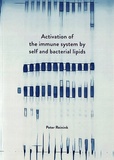Activation of the immune system by self and bacterial lipids

Reinink, Peter
- Promoter:
- Prof.dr. W. (Willem) van Eden
- Co-promoter:
- Dr. I. (Ildiko) van Rhijn
- Research group:
- Eden
- Date:
- April 25, 2019
- Time:
- 10:30 h
Summary
Nowadays, numerous vaccines for infectious diseases are available and these vaccines contribute greatly to public health. Unfortunately, not all vaccines provide perfect protection. The aim of this thesis is to study the possibility to use lipids from pathogenic bacteria to create new vaccines or improve existing vaccines. Bacterial lipids can be presented to T cells by CD1 molecules. These T cells get activated when they recognize the CD1-lipid complexes with their T cell receptor. Members of the family of CD1 molecules have been identified in all mammalian species studied so far. In chapters 3, 4, and 5 we focused on presentation of bacterial lipids by the human CD1b molecule. Surprisingly, we found that several self-lipids can also bind to the CD1b molecule and are being recognized by T cells. These self-lipids can be lipids that are highly abundant in the cells, for example cell membrane lipids. We describe the mechanism by which one T cell can recognize a CD1 molecule with different lipids bound. Furthermore, we identified a T cell receptor that can recognize a lipid from Borrelia Burgdorferi, the bacterial species that causes Lyme disease. That same T cell receptor can also bind to CD1b when a related self-lipid is bound to the CD1 molecule. The ability to react both on a pathogen-derived and self-lipid suggests that vaccination with lipids can possibly trigger an auto immune reaction. Besides being presented to T cells by CD1 molecules, lipids can stimulate the immune system by triggering innate immune receptors. Using a lipidomics approach, we identified two previously unknown, structurally related lipids present in pathogenic Salmonella species, including S. Typhi. We identified a gene that is essential for the biosynthesis the two lipids. One of the lipids, which we named diphosphatidyl trehalose (diPT), is able to bind the monocyte-inducible C-type lectin (MINCLE) receptor and thereby is able to activate the innate immune system. The activation of the MINCLE receptor by lipid adjuvants is already used to increase vaccines efficiency. DiPT might be a good candidate to study as a new adjuvant.